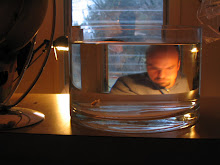Friday, April 25, 2014
Overlays
This is a picture of Cleo on a swing, taken yesterday. But to me, it's also a palimpsest: a visual layering of moments. And in two quick paragraphs, I'll try to explain why.
In yesterday's post, I mentioned Samuel Barber's Adagio for Strings. It's a well-known piece of music that was arranged in 1936 and then first performed in 1938. But it is also, one could argue, a composition that has acquired, over the decades, a range of associations and inflections that could never have been foreseen by Barber. For instance, it was broadcast over the radio in 1945 to accompany the news of the death of Franklin Roosevelt. It was played at the funeral of Princess Grace of Monaco. It was played during the opening ceremonies of the 2010 Winter Olympics, in Vancouver - only hours before the fatal crash of the luger Nodar Kumaritashvili. Or perhaps you remember it from The Elephant Man, or the climactic scene of Platoon - or, more recently, from Michael Moore's Sicko. Regardless, these accrued histories now coat the piece almost like a rich patina. The work, heard now, bears its past like a residue.
And so, in my mind, does that swing. I first saw it, I think, in the fall of 2011, at a Bolton Hill Nursery picnic. Cleo was a Bluebird, and thus not yet allowed to use the adjacent playground equipment. And the swing, which we called a big girl swing, was still daunting: Cleo gravitated instead to the safer, more familiar bucket swings. Over time, though, she and her friends began to test their skills on the big swings, too: in their second year at the school, several of them developed a move in which they ran a short distance and then fell on the swing seat with their belly, arcing into space like, say, a horse borne by a sling danging from a helicopter. In time, though, 2013 became 2014, and now the kids were climbing up into the swings, and sitting upright, and pumping their legs: in short, they were swinging. With casual smiles on their faces.
So she swings. Barber's music plays on my computer speakers. And I, in the present, am gently led through a series of overlaid associations: a series of silts that form the delta of a river we observe, but can never fully fathom.
Subscribe to:
Post Comments (Atom)
.JPG)




No comments:
Post a Comment